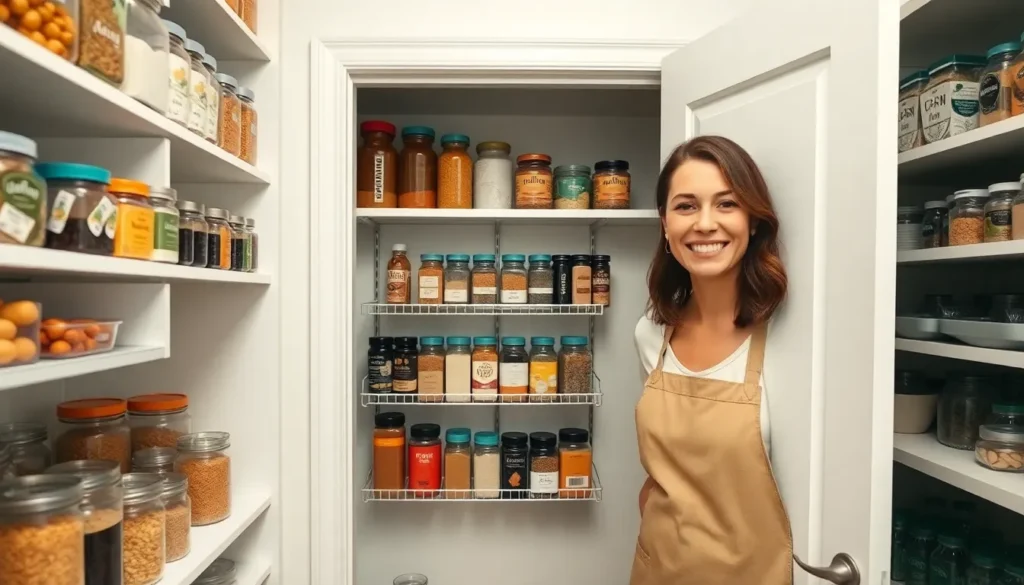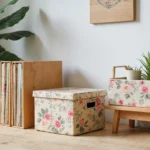We’ve all been there – staring at our cramped pantry wondering how to make the most of every precious inch. Small pantries don’t have to mean compromised organization or constant frustration when searching for ingredients. With the right strategies and creative answers we can transform even the tiniest storage spaces into highly functional food storage systems.
The secret lies in maximizing vertical space utilizing smart storage containers and implementing organizational systems that actually work for your lifestyle. Whether you’re dealing with a narrow closet-sized pantry or just a few shelves we’ll show you how to create more storage capacity than you ever thought possible.
Ready to turn your small pantry into an organized powerhouse? We’re about to share game-changing ideas that’ll help you store more keep everything visible and make meal prep infinitely easier.
Maximize Vertical Space With Tall Shelving Solutions
When dealing with limited floor space, we need to think upward to unlock our pantry’s full potential. Vertical storage answers can triple your available space while keeping everything within easy reach.
Install Floor-to-Ceiling Shelves
Floor-to-ceiling shelves transform unused wall space into valuable storage real estate. We recommend installing adjustable wire shelving units that extend from floor to ceiling, creating multiple storage levels for different pantry items. These systems typically cost between $50-150 and can hold up to 350 pounds per shelf.
Metal shelving units work best because they’re lightweight yet sturdy, and they allow air circulation around stored items. You’ll want to secure the top of tall units to the wall using brackets to prevent tipping. Store frequently used items like cereals and snacks on middle shelves, while keeping bulk items and appliances on lower levels.
Consider adding shelf liners to prevent small items from falling through wire gaps. Glass jars filled with pasta and grains look attractive on upper shelves, while heavier items like canned goods belong closer to the ground for safety and accessibility.
Use Stackable Storage Containers
Stackable containers maximize vertical space while keeping pantry items organized and visible. We’ve found that clear, airtight containers in uniform sizes create the most efficient storage system. Square or rectangular containers use space more effectively than round ones, fitting together without wasted gaps.
Invest in containers that nest inside each other when empty to save storage space. Popular sizes include 1-quart containers for snacks, 2-quart for cereals, and 4-quart for bulk items like flour and sugar. Label each container clearly on the front and top for easy identification.
Stack similar-sized containers to create stable towers that won’t topple over. Place lighter items like crackers and chips in upper containers, while keeping denser foods like rice and beans in bottom containers. This arrangement prevents crushing and makes accessing items safer.
Add Over-the-Door Organizers
Over-the-door organizers instantly add storage without taking up any floor or shelf space. We recommend installing a multi-tier rack on the inside of your pantry door to hold spices, condiments, and small packaged goods. These organizers typically feature 4-6 narrow shelves perfect for items under 4 inches deep.
Choose organizers with adjustable shelves to accommodate bottles and jars of different heights. Metal wire racks work well for heavier items, while plastic organizers suit lighter products like seasoning packets and tea bags. Many units can hold up to 40 pounds when properly mounted.
Mount the organizer using screws rather than over-the-door hooks for better stability and weight capacity. Position frequently used items like cooking oils and vinegars at eye level, while keeping backup supplies and specialty ingredients on higher shelves. This setup keeps daily essentials within arm’s reach while you’re cooking.
Utilize Cabinet Doors for Extra Storage

Your pantry doors offer valuable real estate that’s often overlooked in small spaces. We can transform these vertical surfaces into functional storage areas that keep items accessible while freeing up precious shelf space.
Mount Spice Racks on Interior Doors
Spice racks mounted on the interior of cabinet doors maximize storage for small jars and bottles. We recommend installing narrow wire or acrylic racks that can hold multiple rows of spices without interfering with door closure. This placement keeps spices visible and easy to grab during meal prep rather than hidden behind other items on shelves.
Magnetic racks offer another excellent option for metal pantry doors. These removable answers allow us to adjust storage as our spice collection grows. Adhesive pouches work well for lightweight packets and small containers on wooden or laminate doors.
Install Wire Baskets for Small Items
Wire baskets attached to pantry doors create perfect storage for snacks, seasoning packets, and tea bags. We suggest choosing stackable baskets that provide clear visibility of contents while maximizing vertical door space. These baskets work especially well for items we reach for frequently throughout the day.
Over-the-door organizers with multiple wire compartments can hold various small pantry items without requiring permanent installation. This flexibility allows us to rearrange storage as our needs change while keeping everything within easy reach.
Create a Command Center With Hooks and Clips
Hooks and clips transform pantry doors into functional command centers for daily kitchen activities. We can hang meal plans, grocery lists, and small kitchen tools using simple adhesive hooks that don’t damage door surfaces. Aprons, oven mitts, and reusable shopping bags find convenient homes on sturdy hooks.
Clips attached to a small board or magnetic strip organize coupons, recipes, and reminders effectively. This system centralizes kitchen planning activities while keeping important information visible and accessible. The pantry becomes more than just storage—it’s a hub for daily meal organization and preparation.
Implement Clear Storage Containers for Easy Visibility
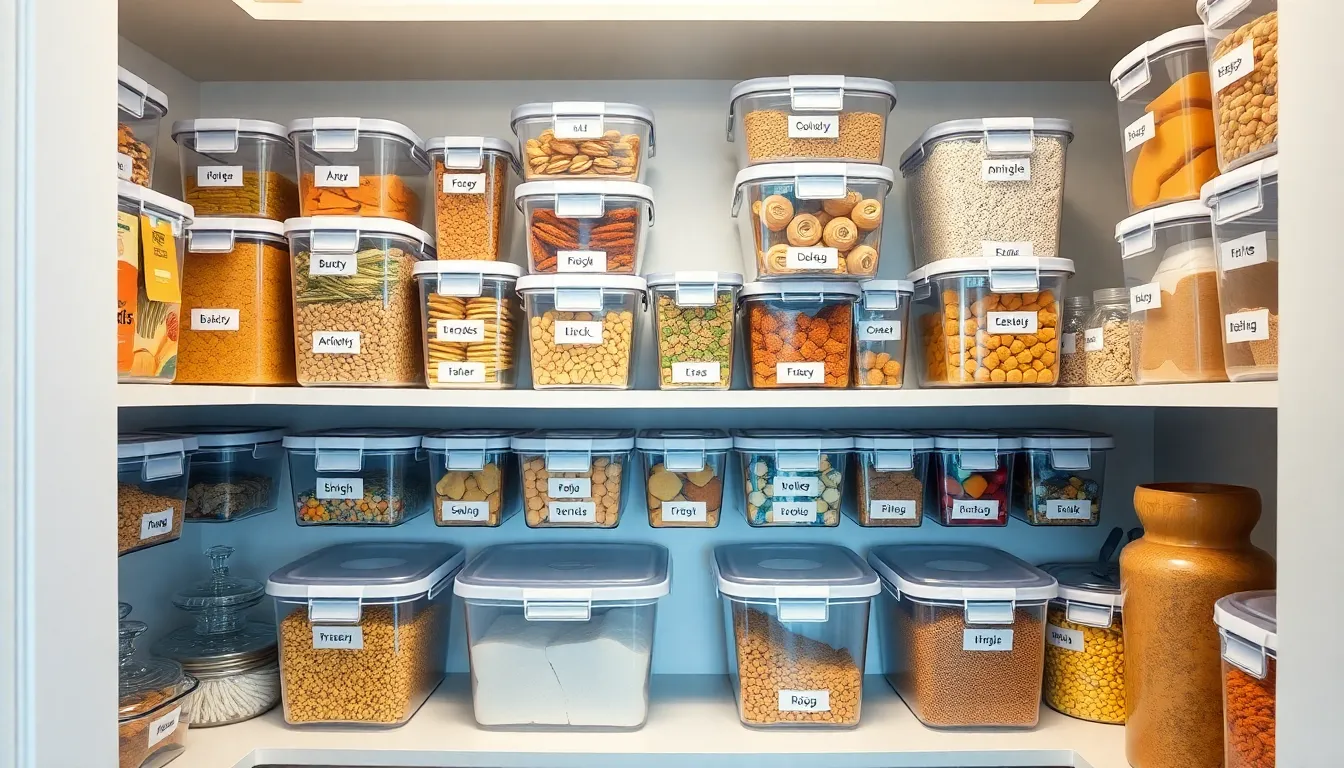
Clear storage containers transform small pantries by eliminating guesswork and reducing food waste. We can instantly see what’s available without opening multiple containers or digging through opaque packaging.
Choose Airtight Containers for Dry Goods
Airtight containers protect dry goods such as grains, cereals, and snacks from moisture, air, and pests while extending shelf life significantly. These sealed storage answers maintain freshness in compact pantry settings where proper food preservation becomes essential. We recommend investing in stackable airtight containers that maximize vertical space while keeping items like flour, rice, pasta, and nuts fresh for months longer than their original packaging would allow.
Clear airtight containers let us monitor stock levels at a peek, preventing over-purchasing and reducing waste. Quality airtight storage prevents spoilage that commonly occurs in small pantries where items might get forgotten behind other products.
Label Everything With a Consistent System
Consistent labeling helps household members identify pantry contents immediately and ensures items return to their correct locations. We should use uniform labels whether printed, handwritten, or erasable to reduce confusion and enhance organization throughout our small pantry space.
Erasable or chalkboard labels offer flexibility for pantries where stock changes frequently, allowing us to update contents without creating label waste. Printed labels work best for permanent storage items, while erasable options suit containers that hold different products over time.
Label placement should remain consistent across all containers, positioning them at eye level on the front face for maximum visibility and quick identification.
Use Transparent Bins for Grouped Items
Stackable clear bins optimize space utilization by allowing us to group similar items like baking supplies, snacks, or canned goods while maximizing vertical storage capacity. These transparent storage answers prevent clutter and make inventory management more efficient in confined pantry spaces.
Grouped transparent bins help us track available stock and minimize waste by keeping related items visible and accessible. We can stack bins containing breakfast items, dinner ingredients, or specialty cooking supplies to create organized zones within our small pantry.
Clear bins work particularly well for irregularly shaped items that don’t fit standard containers, such as seasoning packets, tea bags, or small condiment bottles that might otherwise create visual chaos in limited storage areas.
Create Zones for Different Food Categories
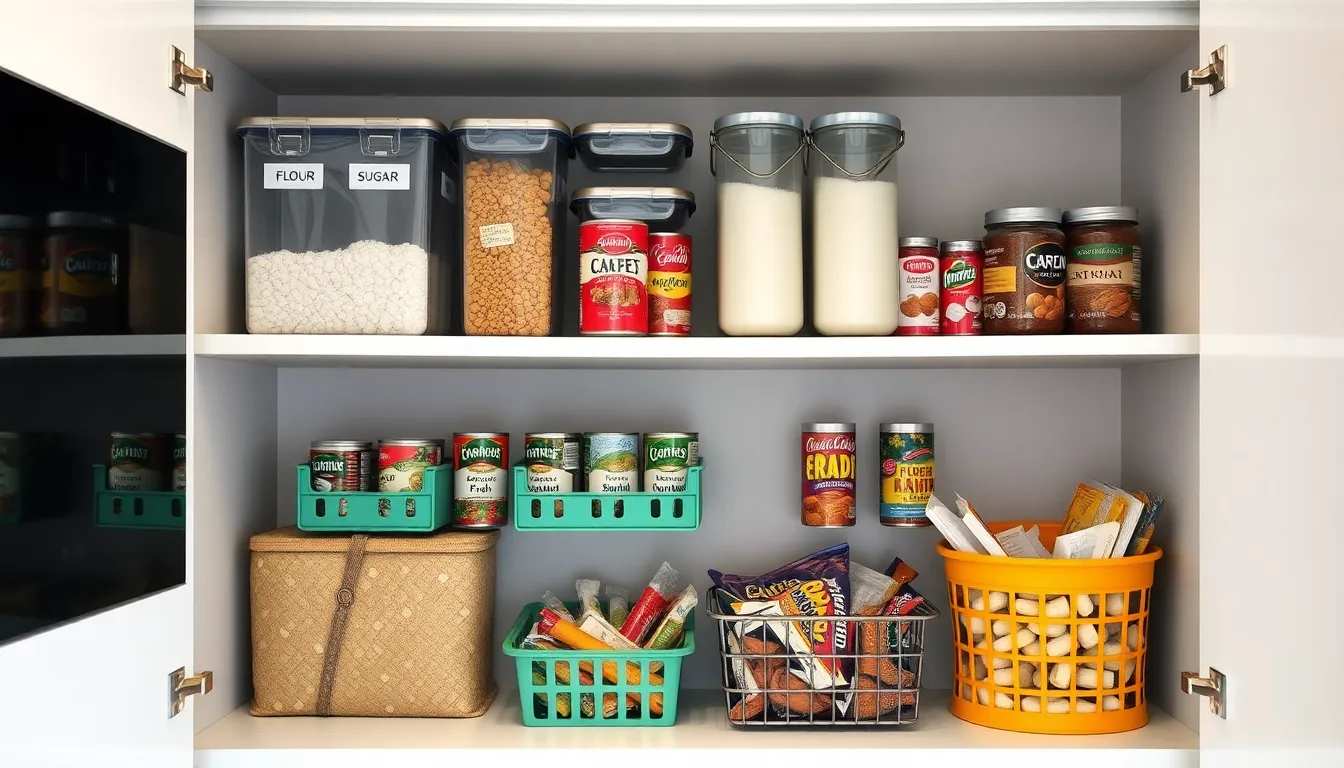
Dividing your small pantry into exact zones transforms chaotic storage into an organized system that saves time and reduces food waste. We’ll show you how to assign dedicated areas for different food types to maximize efficiency.
Designate Areas for Baking Supplies
Reserve a exact shelf or section exclusively for baking supplies to streamline your cooking process. Store flour, sugar, baking powder, and vanilla extract together in labeled containers that keep ingredients fresh and easily accessible. Position measuring cups and mixing spoons within this zone to create a complete baking station.
Label each container clearly with both the contents and expiration dates to maintain freshness and prevent confusion. Use airtight containers to protect baking ingredients from moisture and pests, which can compromise quality and extend shelf life significantly.
Group Canned Goods by Type
Organize canned goods by category rather than randomly placing them throughout your pantry space. Create separate areas for vegetables, fruits, meats, and soups to make meal planning more efficient and inventory tracking simpler.
Stack similar items using stackable containers or baskets that maximize vertical space while keeping products visible. Place frequently used canned goods at eye level and bulk purchases on lower shelves for optimal accessibility.
Separate Snacks and Quick-Grab Items
Establish a dedicated snack station on a low shelf or in a drawer that family members can access quickly. Use baskets or bins to contain chips, crackers, granola bars, and other portable snacks, preventing them from scattering throughout the pantry.
Position this snack zone at an accessible height for children while keeping healthier options at the front of containers. Group similar snack types together using clear containers so everyone can see available options without opening multiple packages.
Add Pull-Out Drawers and Sliding Baskets
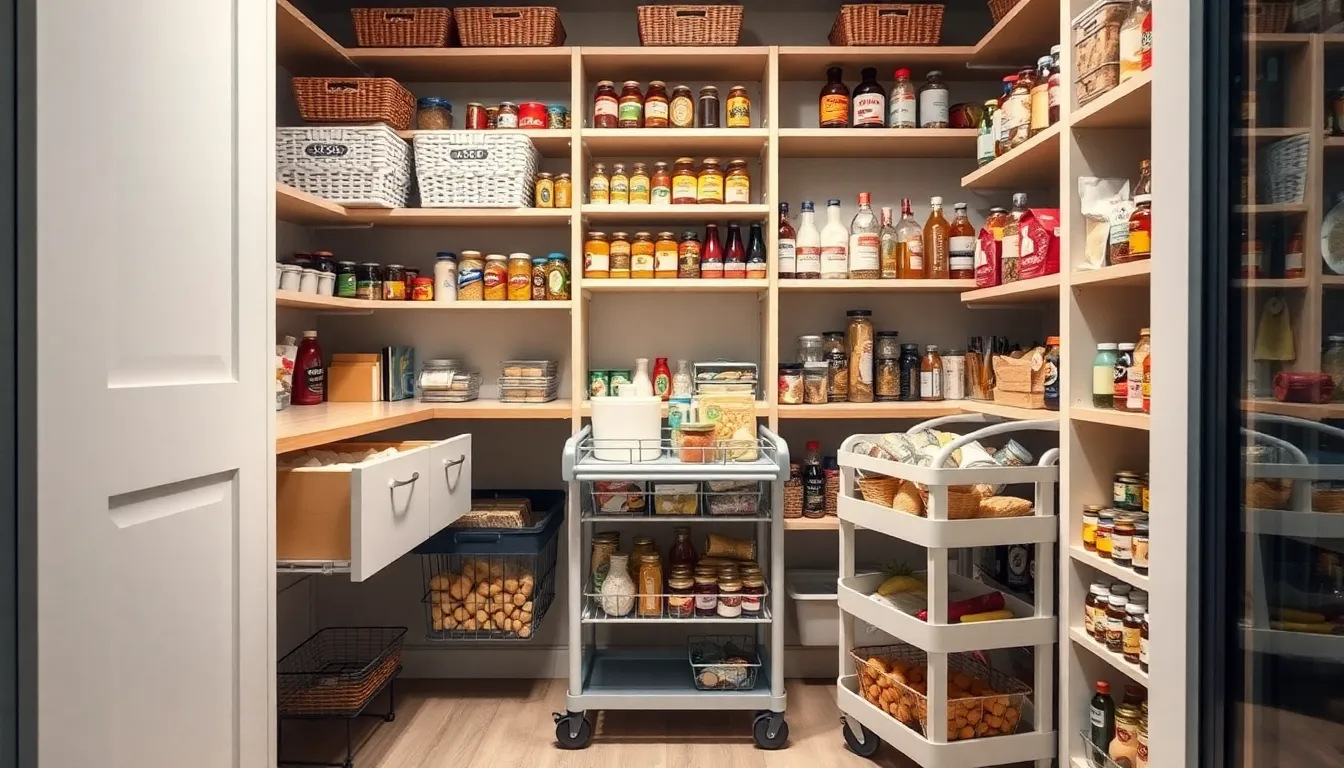
Pull-out drawers and sliding baskets maximize accessibility in your small pantry by allowing you to retrieve items from the back without disturbing everything in front. These storage answers work exceptionally well in narrow or deep cabinets where items often get lost behind other products.
Install Drawer Slides in Deep Cabinets
Deep shelves present unique challenges when we’re trying to use every inch of our small pantry space efficiently. Installing drawer slides transforms these awkward deep spaces into functional pull-out drawers that improve access to items stored in the back corners. This setup proves especially beneficial for bulk goods and heavy containers that we don’t want to lift repeatedly when searching for other items. Drawer slides make deep cabinet spaces more user-friendly while maintaining the organized structure we’ve established with our pantry zones.
Use Rolling Carts for Flexible Storage
Rolling carts provide movable storage units that adapt to our changing pantry needs while fitting inside or outside the main storage area. We can reorganize our pantry layout with ease using these versatile units that hold canned goods, snacks, or baking supplies. These mobile answers allow us to roll ingredients directly to our prep area when cooking, eliminating multiple trips back and forth. Rolling carts add extra storage capacity when we need it most while maintaining the flexibility to move them out of the way during deep cleaning sessions.
Incorporate Lazy Susans for Corner Access
Lazy Susans rotate to make corner spaces and deep shelves accessible without the frustration of reaching into dark recesses. These turntables keep food items visible and prevent the clutter that often accumulates in awkward pantry corners. We can use lazy Susans for spices, jars, snacks, or canned goods to make full use of otherwise wasted corner space in our small pantries. Rotating platforms work particularly well in our established zones, allowing us to group similar items while maintaining easy access to everything we’ve organized.
Optimize Shelf Spacing With Adjustable Systems

Adjustable shelving systems transform small pantries by accommodating different sized items while maximizing every inch of vertical space. We’ll explore three key strategies that’ll help you customize your storage configuration for optimal efficiency.
Install Modular Shelving Units
Modular shelving units provide the ultimate flexibility for customizing your pantry’s storage capacity. These systems adapt to your exact pantry dimensions while allowing you to reconfigure shelves as your storage needs change throughout the year.
Installing these units starts with measuring your pantry’s width and height precisely. Most modular systems feature interlocking components that snap together without requiring tools or permanent mounting. Wire modular units work exceptionally well because they promote air circulation around stored items like cereals and crackers.
Configure your modular shelves with taller spaces at the bottom for bulk items like bags of rice or large containers. Position medium height shelves at eye level for frequently accessed ingredients such as cooking oils and spices. Reserve the narrower upper spaces for lightweight items like pasta boxes and snack packages.
Use Shelf Risers to Double Storage Space
Shelf risers effectively double your storage capacity by creating two distinct levels on existing shelves. We recommend installing risers that measure 6 to 8 inches in height for optimal visibility and accessibility.
Position your risers toward the back of shelves to create a stepped storage system. Place shorter items like spice jars and small bottles in front while storing taller containers like cereal boxes behind the riser. This arrangement ensures you can see and reach every item without moving multiple products.
Metal shelf risers offer the sturdiest support for heavy items like canned tomatoes and sauces. Bamboo risers work perfectly for lighter goods such as tea boxes and seasoning packets while adding a natural aesthetic to your pantry design.
Add Undershelf Baskets for Extra Room
Undershelf baskets attach directly beneath existing shelves to capture otherwise wasted vertical space. These baskets slide or hook into place without requiring any permanent modifications to your pantry structure.
Install wire undershelf baskets to store lightweight items like snack bars and small containers. The open wire design maintains visibility while allowing air to circulate around stored products. Position these baskets on shelves that have at least 4 inches of clearance underneath.
Use undershelf baskets for frequently accessed items such as grab and go snacks or daily supplements. This placement keeps these products easily reachable while preserving valuable main shelf space for larger containers and bulk ingredients.
Think Outside the Box With Creative Storage Ideas
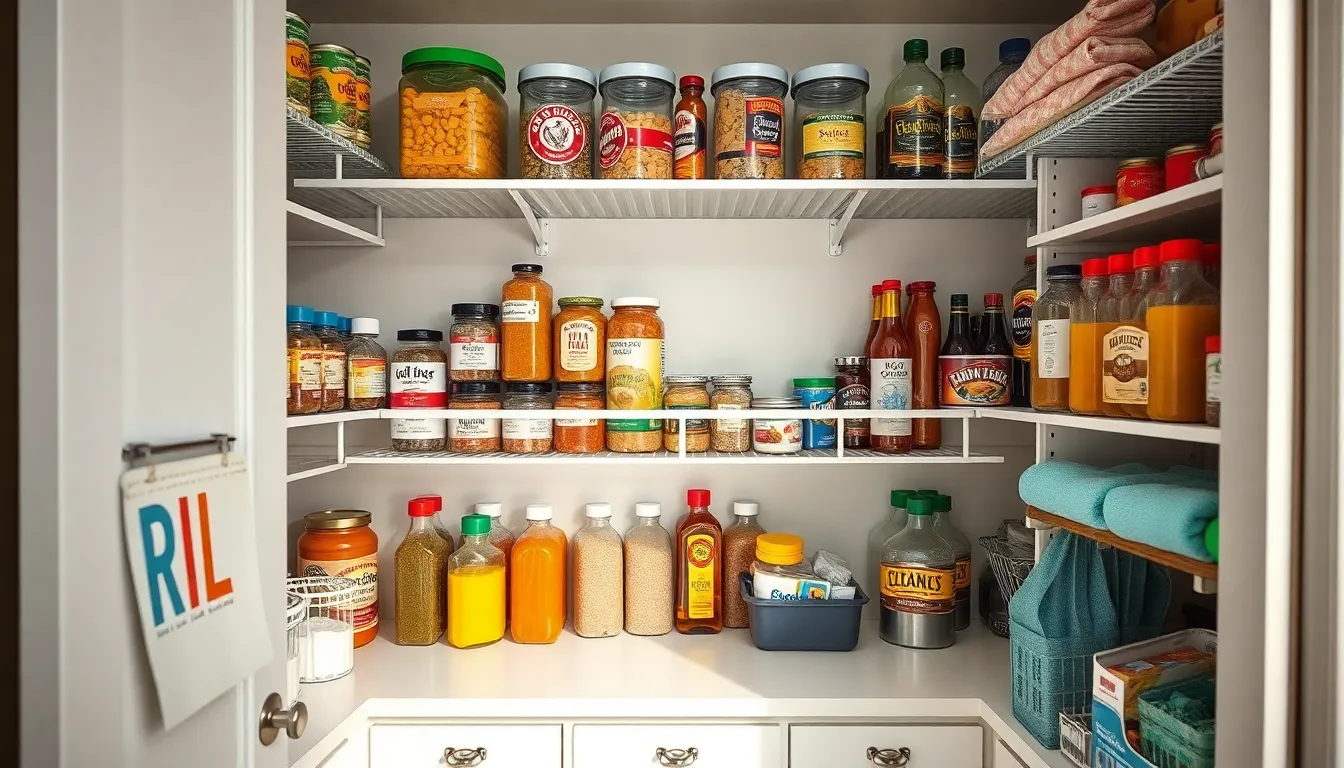
Unconventional storage answers can unlock hidden space potential in our small pantries. Creative repurposing transforms everyday household items into efficient organizational tools.
Repurpose Magazine Holders for Cutting Boards
Magazine holders become instant cutting board organizers when we position them on pantry shelves. These vertical storage answers keep cutting boards upright and easily accessible while freeing valuable horizontal space. Plastic magazine holders work best since they’re lightweight and easy to clean. Position them near our prep area for quick access during meal preparation. Multiple holders accommodate different board sizes from small to extra large.
Use Tension Rods to Hang Cleaning Supplies
Tension rods create instant hanging storage without requiring permanent installation. Install them between pantry walls to hang spray bottles, dish towels, and cleaning cloths. These adjustable rods work perfectly in narrow spaces where traditional shelving won’t fit. Position them at comfortable heights for easy access to frequently used supplies. Strong tension rods support multiple lightweight items while keeping our floor space clear.
Transform Dead Space Into Storage Nooks
Under stair spaces become valuable pantry storage when we install custom drawers or shelving units. These awkward areas work perfectly for storing infrequently used goods or small items that don’t require daily access. Over door racks attached to pantry doors maximize vertical space for spices, oils, and cleaning supplies. Magnetic spice strips placed on metal surfaces or doors hold spice containers while keeping them visible and organized. Corner spaces benefit from triangular shelves that fit perfectly into dead angles, creating storage where none existed before.
Maintain Organization With Regular Decluttering

We’ve transformed our storage spaces with smart containers and zones, but maintaining that organization requires consistent effort. Regular decluttering sessions prevent small pantries from becoming overwhelming again.
Establish a Monthly Inventory System
Tracking what we have prevents overbuying and ensures we’re using our limited pantry space efficiently. Professional organizers recommend using labeled bins, clear containers, or digital tracking apps to monitor stock levels throughout the month.
Creating a simple inventory checklist helps us stay on top of what’s running low and what needs to be used soon. Digital apps make this process even easier by sending reminders when items are getting low or approaching expiration dates.
Monthly inventory checks also reveal patterns in our shopping habits. We might discover we’re buying too much of certain items or forgetting about products tucked away in corners.
Rotate Stock Using First In First Out Method
Implementing the FIFO method ensures older items get used before new purchases, reducing waste and keeping our pantry fresh. This rotation technique works especially well for perishables and packaged goods that have expiration dates.
Clear bins make it easy to distinguish between older and newer products at a peek. We can place newer items in the back and older ones in front, creating a natural flow that prevents forgotten items from expiring.
Labeled shelves help maintain this system by providing designated spots for rotated stock. When we restock groceries, we automatically move older items forward and place new ones behind them.
Remove Expired Items Consistently
Checking expiration dates at least once a month keeps our pantry safe and prevents spoiled food from taking up valuable space. Home organization experts suggest creating a “soon to expire” section for items that need priority use.
Labeling containers with expiration dates makes these checks faster and more thorough. We can quickly scan our pantry and identify items that need immediate attention without having to check every single product.
Regular removal of expired items also prevents the buildup of clutter that makes small pantries feel even more cramped. This simple habit maintains the clean, organized look we’ve worked hard to achieve.
Conclusion
Creating an organized and efficient small pantry isn’t about having more space—it’s about using what we have more intelligently. By implementing these strategic storage answers we can transform even the tiniest pantry into a well-organized system that works for our daily routines.
The key lies in combining multiple approaches: maximizing vertical space with shelving systems adding smart storage containers for visibility and establishing zones that make sense for our cooking habits. When we layer these techniques together they create a comprehensive organizational system that grows with our needs.
Remember that maintaining organization requires ongoing effort but the time invested pays dividends in reduced food waste easier meal preparation and less kitchen stress. With these proven strategies we can turn our small pantry challenges into storage victories that make cooking more enjoyable and efficient.
Frequently Asked Questions
What are the best ways to maximize vertical space in a small pantry?
Install floor-to-ceiling shelves to triple your storage capacity while keeping items accessible. Use adjustable wire shelving units for durability and air circulation. Place frequently used items at eye level and store bulk items on lower shelves. Add stackable storage containers and over-the-door organizers to utilize every inch of vertical space without consuming floor area.
How can I use my pantry door for extra storage?
Transform your pantry door into valuable storage by mounting spice racks on the interior for easy visibility and access. Use magnetic racks for metal doors or adhesive pouches for lightweight items. Attach wire baskets for snacks and seasoning packets. Create a command center with hooks and clips for meal plans, grocery lists, and small kitchen tools.
Why should I use clear storage containers in my pantry?
Clear containers enhance visibility, allowing you to see contents without opening multiple containers, which reduces food waste. They help you quickly identify what you have and what you need. Choose airtight containers for dry goods to protect against moisture and pests, extending shelf life and maintaining freshness while keeping your pantry organized.
What’s the best way to organize pantry zones?
Create specific zones for different food categories to enhance efficiency. Designate a shelf for baking supplies with labeled, airtight containers. Group canned goods by type—vegetables, fruits, meats, and soups—for easier meal planning. Establish a dedicated snack station using baskets or bins to keep portable snacks organized and easily accessible.
How can pull-out drawers and sliding baskets help my small pantry?
Pull-out drawers and sliding baskets maximize accessibility in narrow or deep cabinets. Install drawer slides in deep cabinets to transform awkward spaces into functional storage. Use rolling carts for flexible storage that can adapt to your pantry layout. Incorporate Lazy Susans in corner spaces to keep items visible and prevent clutter.
What are some creative storage solutions for small pantries?
Repurpose magazine holders as cutting board organizers to keep them upright and accessible. Use tension rods to hang cleaning supplies in narrow spaces. Transform dead spaces like under-stairs areas into storage nooks with custom shelving. Utilize over-door racks and magnetic spice strips to maximize every available inch of space.
How do I maintain an organized pantry long-term?
Schedule monthly decluttering sessions to prevent overwhelming clutter. Establish an inventory system using labeled bins or digital apps to track stock levels. Implement the First In First Out (FIFO) method to use older items before new purchases. Create a “soon to expire” section and regularly check for expired items to maintain freshness and organization.

